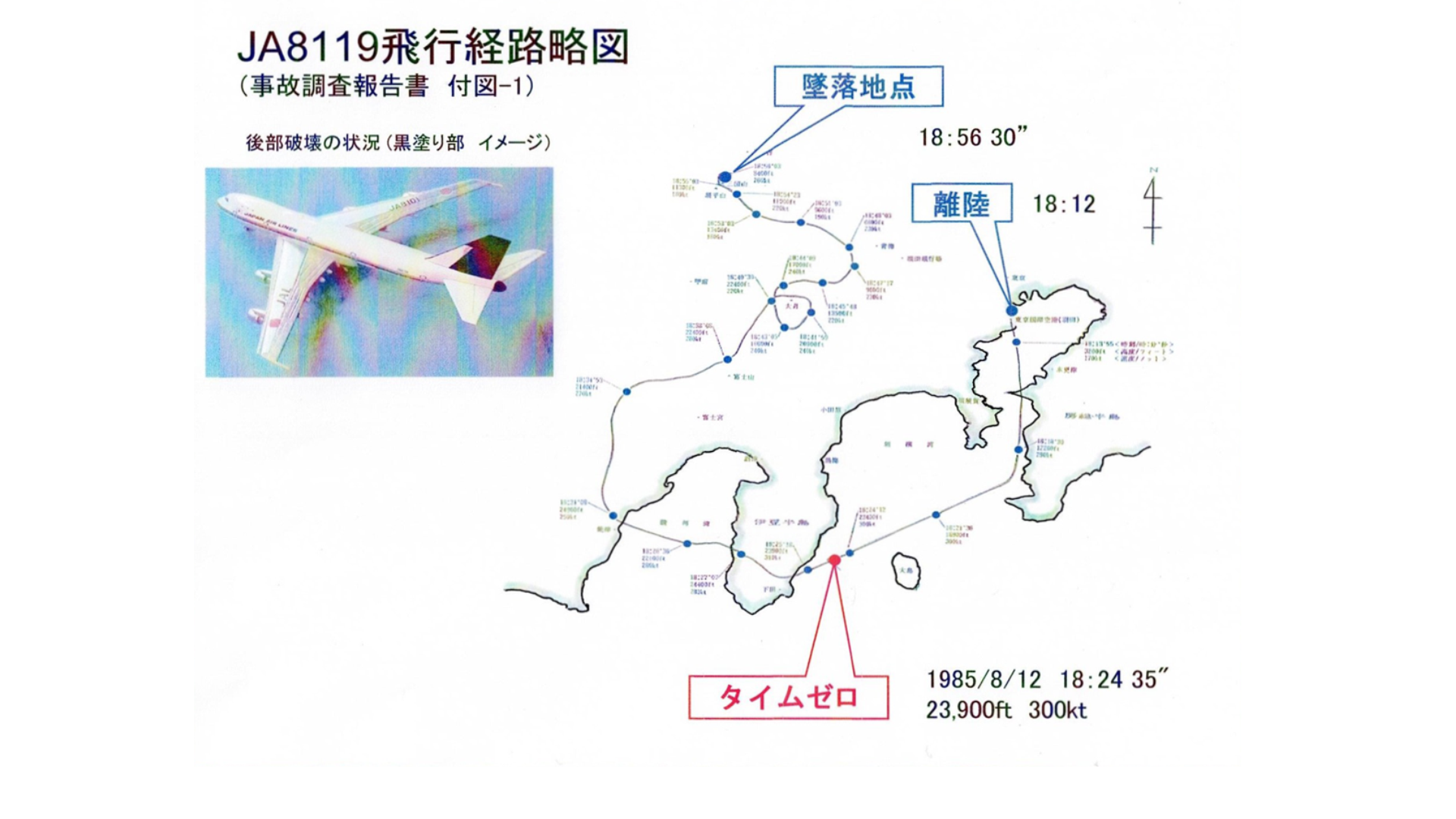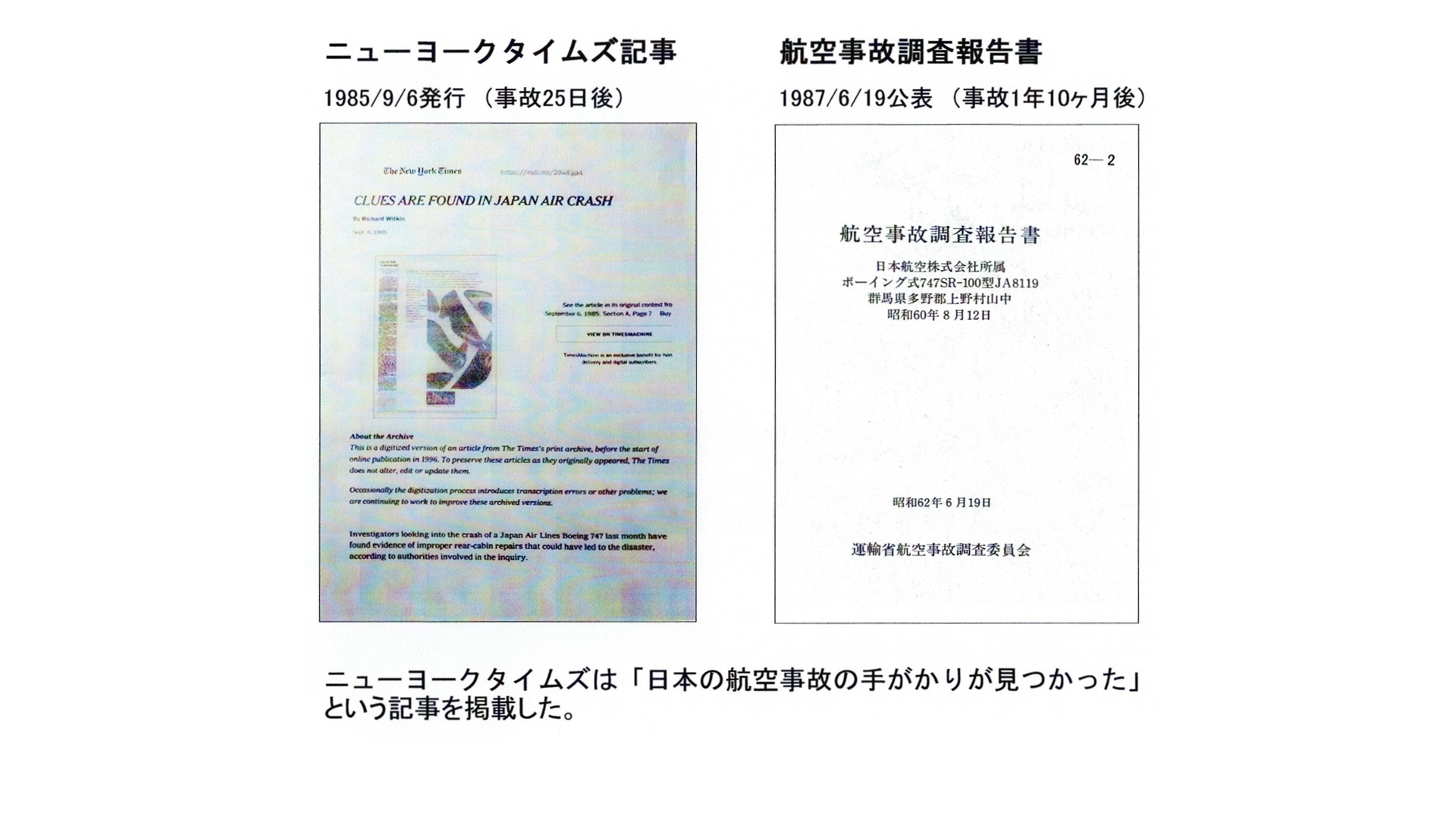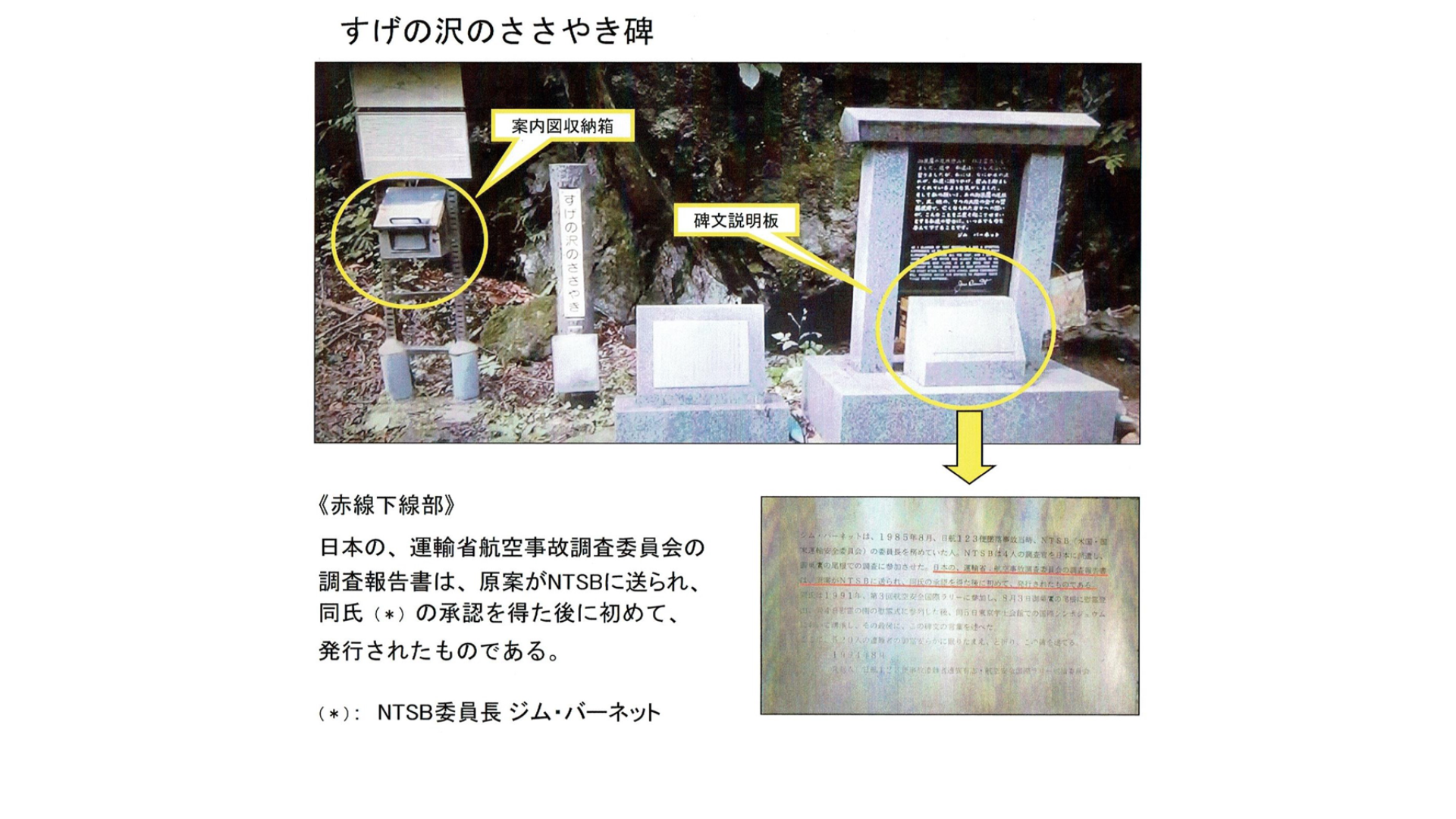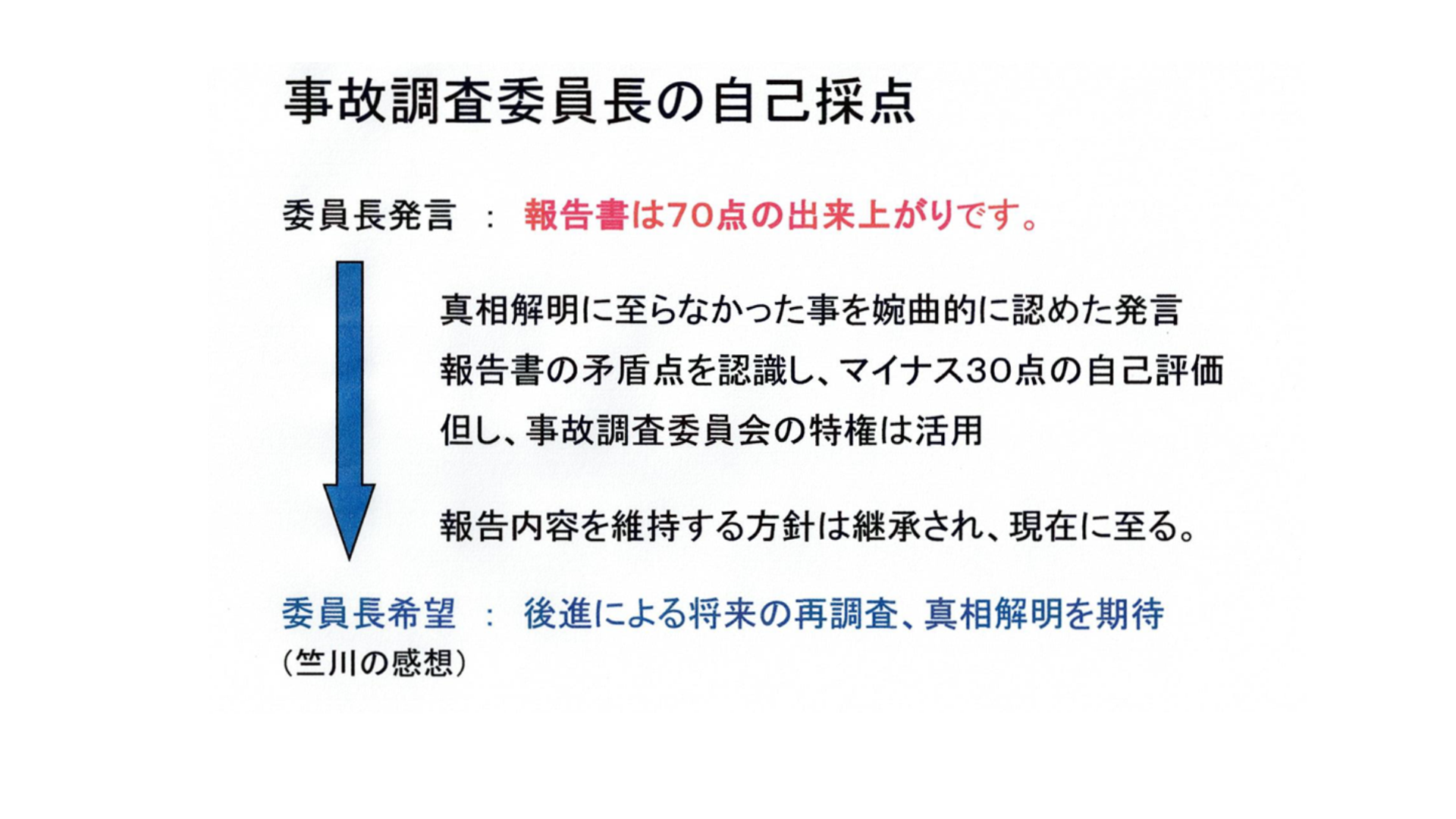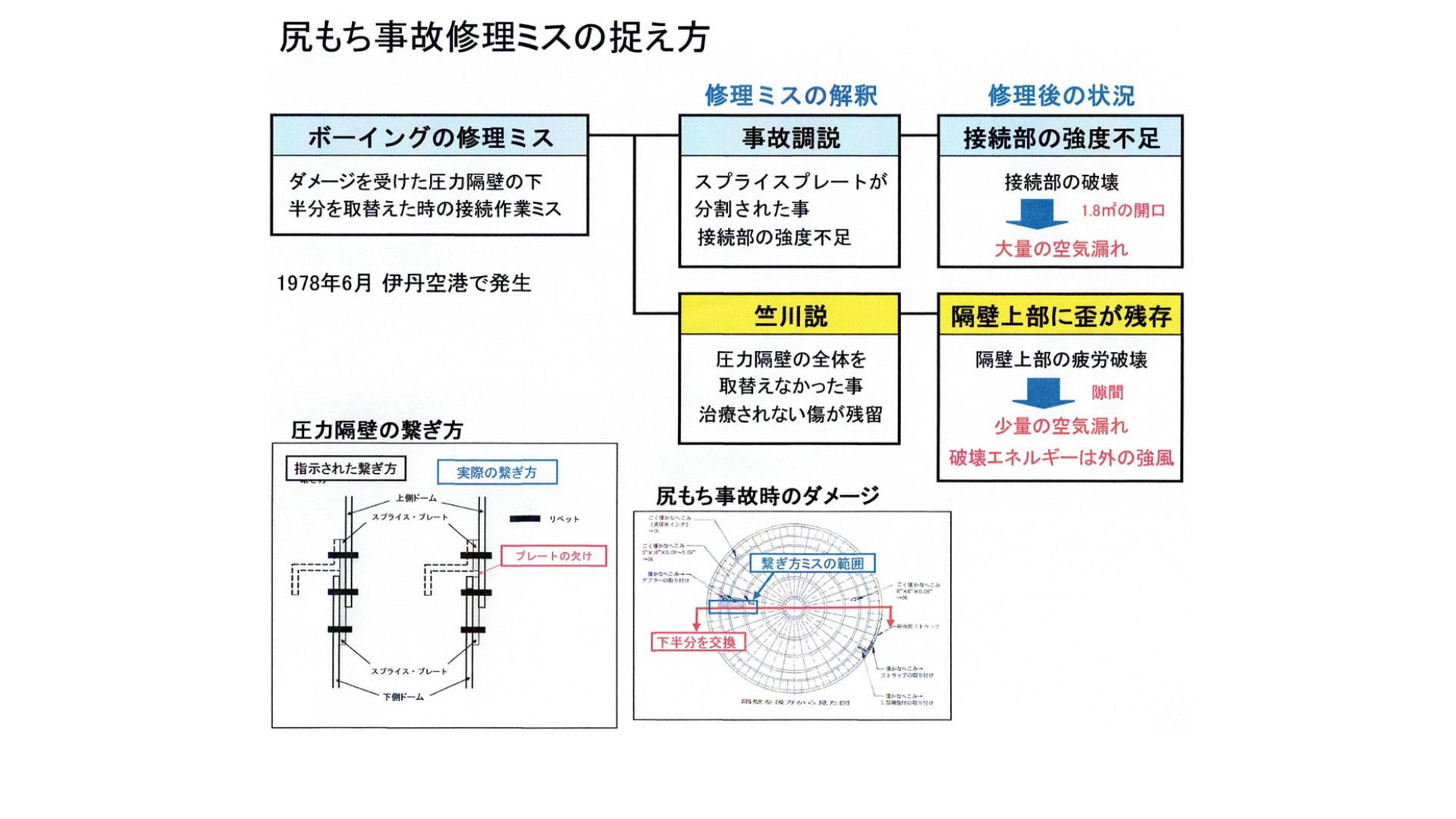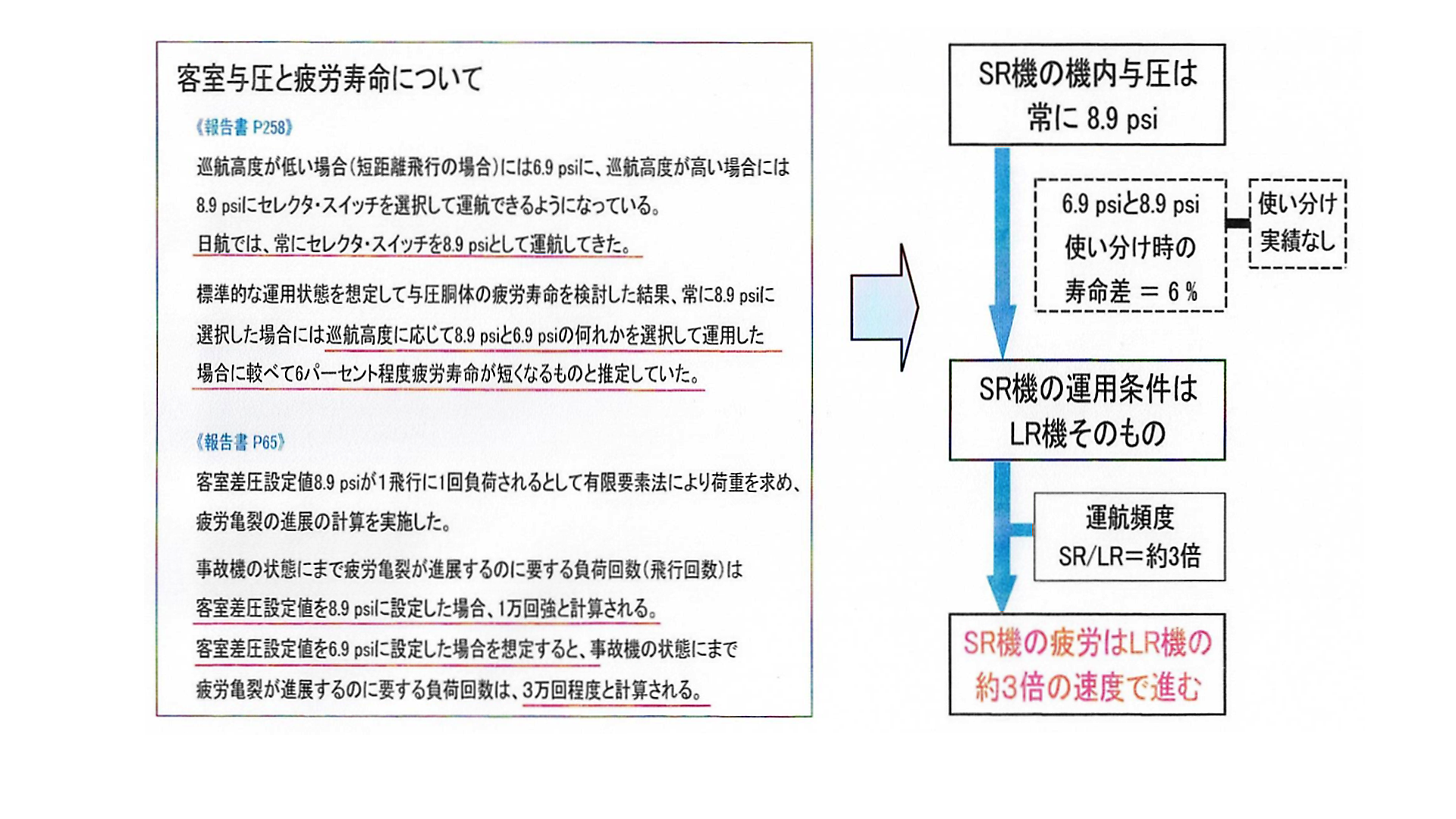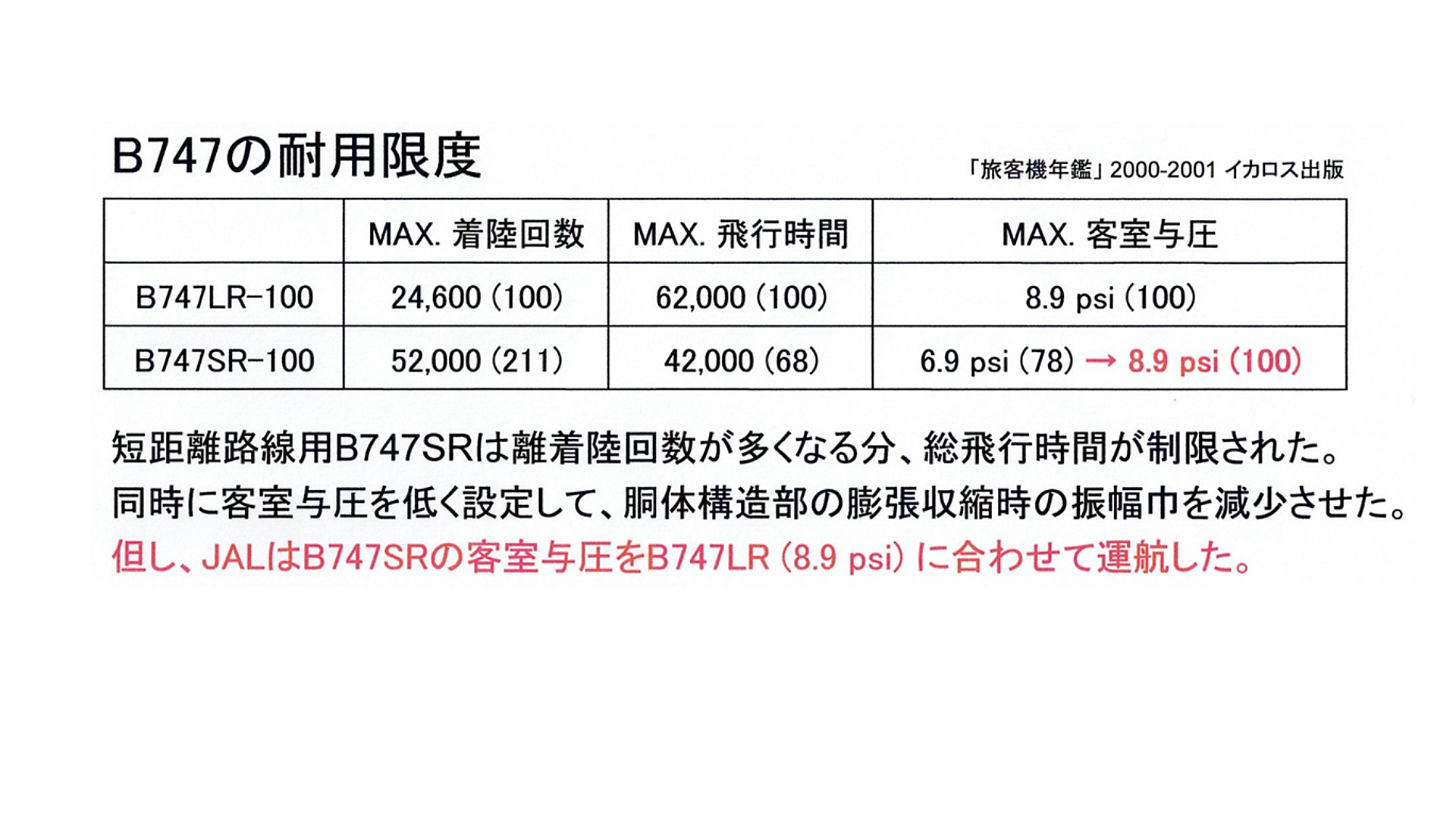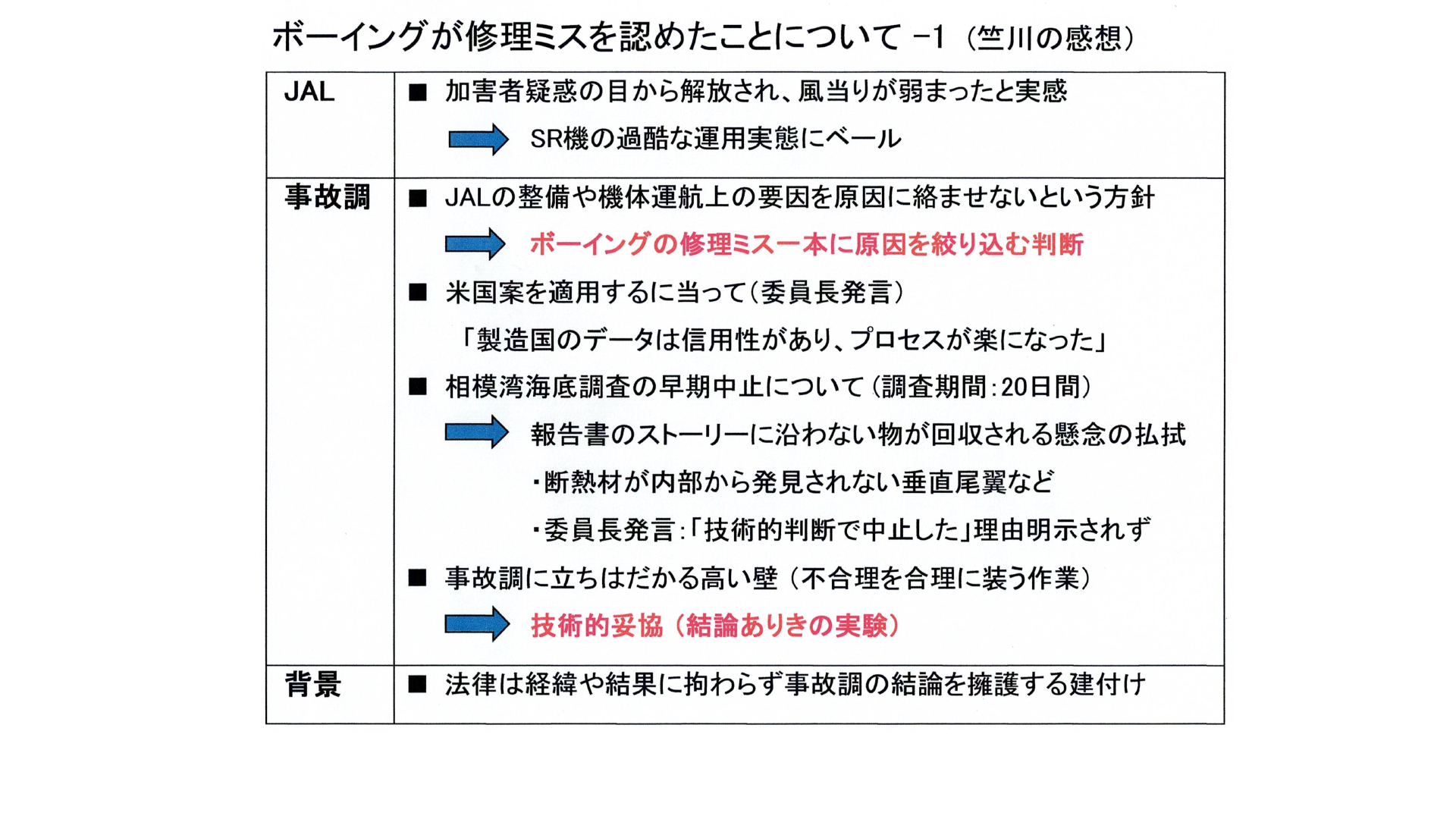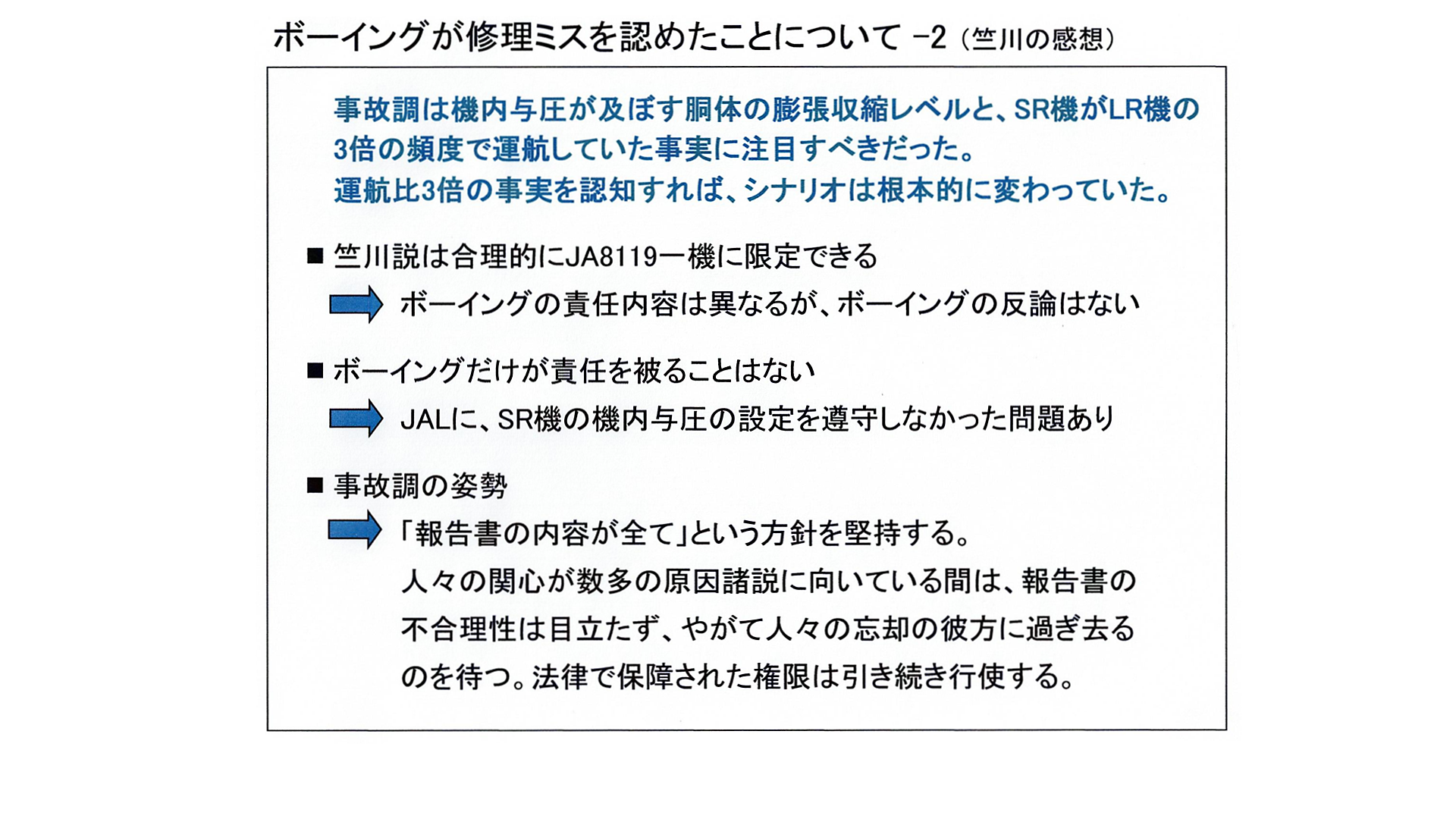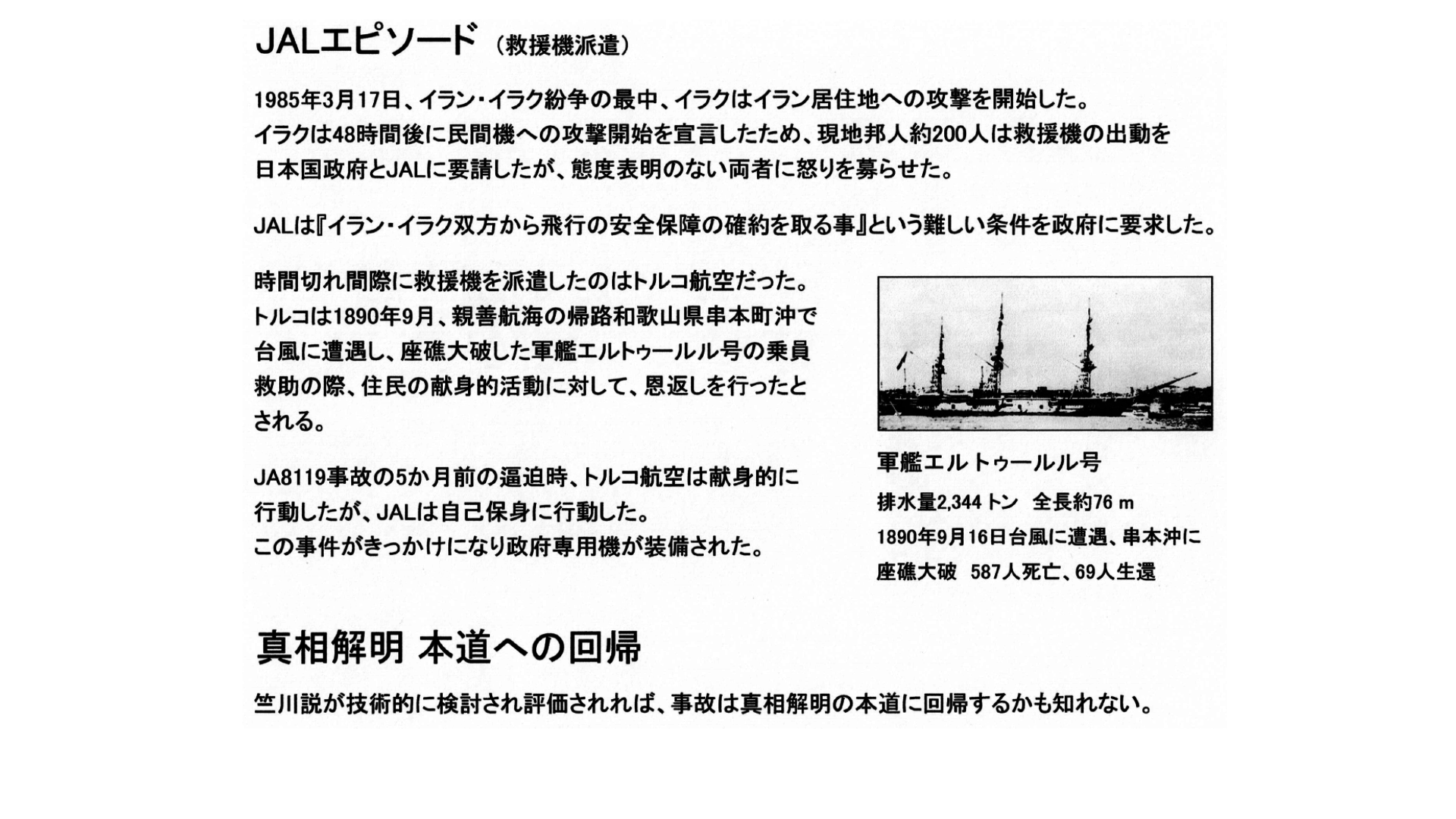Wings of Silence YouTube :Japanese audio with English subtitles
Records tell the truth about the Japan Airlines Flight 123 crash : Omnibus
English subtitles
4. The speculation of the USA and Japan
Fifth is the speculation of Japan and the USA regarding the accident. Let's take a quick look back at the accident. The accident occurred in the evening of August 12, 1985.
JAL123 flight B747SR JA8119 from Haneda to Osaka flies over Sagami Bay to the Izu Peninsula about 12 minutes after takeoff. Around the time, the vertical stabilizer suddenly broke and lost maneuvering function, and after about 32 minutes of stray flight, it crashed on the ridge of Osutaka, killing 520 passengers and crew, and rescued 4 people.
The accident is still recorded as the worst accident in the world as a single aircraft.
Rescue operations and accident investigations began immediately, and a few days later a research team consisting of the US National Transportation Safety Board and Boeing joined the investigation.
JA8119 had a tailstrike accident at landing seven years ago, and Boeing had a history of repairs to replace the lower half of the damaged rear pressure bulkhead.
The US investigation team discovered a repair error that impaired the strength of the joints of the old and new bulkheads. And this discovery seemed like a good one for them.
The reason is that if the cause of the accident is a malfunction that is common to all B747s that were in service around the world at that time, it may lead to a major global problem. However, if the cause is a repair error, it can be narrowed down to the problem of JA8119 alone.
The US side wanted to inform the world as soon as possible that the aircraft in service was safe.
The cause was that the repair mistake part was fatigued and destroyed due to insufficient strength, and a large amount of air flowed out from the opened hole of about 2 square meters.
It was determined that the rear part of the aircraft was destroyed and the maneuvering function was lost.
At this time, NTSB and Boeing made a misjudgment that the cause of the accident was difficult to verify. They seemed unaware of the misjudgment because of such a shocking failure.
The reason why it was difficult to verify was that the outflowing air energy destroyed the rear structure, while people remained conscious until the end without being exposed to oxygen deficiency despite the large hole in the pressure bulkhead. It's a fact.
This misjudgment continues to this day without being corrected. And various theories of causes were flooded in the world.
On September 6, 25 days after the accident, the New York Times published a scoop article that the cause was a Boeing repair mistake.
It is said that the NTSB leaked to the New York Times and reported it because the accident report did not mention the repair mistake of the pressure bulkhead in the interim report.
The photo on the left is the "CLUES ARE FOUND IN JAPAN AIR CRASH" article by The New York Times.
The US side was able to publicize to B747 operators around the world that it was safe regardless of the aircraft in operation.
Immediately after the newspaper report, three of the five accident investigation committee members, including the chairman, resigned. I suspected they couldn't agree with the US intentions.
Looking back on the circumstances that followed, it seems that the US side requested the accident report to compile a report due to a repair error.
The Aircraft Accident Investigation Report was published on June 19, 1987, one year and 10 months after the accident. The right is the cover of the report. I think the reason why it took time to publish was that it was difficult to disguise the scenario entrusted to the accident by the US side as a rational scenario.
The final published report was not scientifically convincing. However, the Investigation Commission was able to insist on this only because of the backing of the law mentioned above. The Investigation Commission has the authority to maintain the conclusions of the report.
The New York Times articles and the contents of the report are lined up, and the common contents of the report are shown in red.
There was a point that I was wondering if that was the case.
First, the accident-like conclusion was exactly the same as the New York Times article. The same is true for the characteristic scenario where the blown air destroyed the vertical stabilizer from the inside due to the lack of strength of the repair part.
The content of the report, published one year and ten months later, was published on the 25th day of the accident, and the New York Times article hit the mark as if it were a prophecy.
The close resemblance to the New York Times article was not a coincidence, and made me feel the strong pressure of the United States on the given scenario.
The Accident Investigation Commission does not know if Boeing's repair mistake theory is correct. However, it cannot be "unknown cause". The reason is that "unknown cause" raises concerns again for all B747s in operation.
Japan, the party concerned, is obliged to publish an accident investigation report. However, time passed by without reaching the root cause that was technically convincing.
The period of 1 year and 10 months was a period of strenuous efforts to make a theory in line with the US-led scenario.
The biggest question in the report is that there is no scientifically convincing explanation as to why people remained conscious despite the large hole in the pressure bulkhead that was the size of a tatami mat.
This photo is "Aviation Knowledge ABC" published by JAL in August 1972. This book states that under almost the same conditions as the JA8119 accident, if one door of about 2 square meters is removed, the air pressure inside the aircraft will be equal to the outside air after 1.5 seconds.
If the air is released at once and the air pressure in the room reaches 0.4 atm, the environment is not in a state where ordinary people can keep consciousness.
There were many comments that the explanation in the report was not convincing, so there was no big hole and no sudden decompression. The "Commentary" published 26 years later inherits the unreasonable eloquence that "people can keep their consciousness" even if a big hole is opened.
The second was in the inscription on the stone monument of Mt. Osutaka. The photo shows the monument and its plate erected by the bereaved family near the trailhead. When I first climbed the memorial service in July 2020, I was surprised to see a single monument.
The main text of the monument says: "The Accident Investigation Commission's investigation report was only published after the draft was sent to the NTSB and approved by Chairman Jim Barnett," said the report approval process. It is written.
It is clear that the report was based on a US-led scenario from the beginning. The Accident Investigation Commission does not affirm or deny, but the report's conclusions are still maintained 37 years later.
"The report is 70 points completed."the accident investigation chairman said. I think it was a statement that implicitly acknowledged the existence of political judgment and technical compromise."
I think it's a euphemism that the report couldn't tell you everything and that the cause was virtually unknown. I interpret that the chairman's 70-point statement, which implicitly admits that it is not perfect, was a statement that he once compromised, but hoped that the younger generation would finish it to 100 points when the environment was ready in the future...
Since both the accident investigator and JAL are a group of experts, they know that the scenario of the report is unreasonable, and I presume that they must have killed the pride of the engineers when the report was published.
There may have been some people who decided to keep what they knew for the rest of their lives. It's no wonder some people thought it could be a big deal if the details of the report were made public. The policy of maintaining the status quo has been taken over, and it is clearly shown in the content of the "commentary" 27 years later.
In the 1990s, all the Boeing development engineers I contacted showed that they wouldn't touch on this issue. The Boeing technicians didn't know the true cause, but I think they knew that the conclusion of the report was unreasonable.
I have fairly obtained B747 flight data from JAL to help clarify the root cause. The data is sufficient to prove the integrity of the Jikusen theory. I would like to supplement a little technically later.
I will review the outline of repair mistakes and how to understand the two theories, the accident report and the Jikusen theory.
Boeing's repair mistake is that the intermediate plate for the repair joint, which should be one piece, has been split for some reason. It was a mistake that I couldn't think of as a professional job, as the burden of rivets increased and the overall strength decreased.
Boeing lost their composure when they witnessed an unthinkable repair mistake. However, it was immediately determined that this repair error could be limited to JA8119, and it seems that the Accident Investigation Committee agreed with that decision.
By the way, the Jikusen theory also cites Boeing's repair mistake as one of the causes, but the viewpoint is completely different.
In short, the Jikusen theory concludes that "the decision not to replace all of the pressure bulkheads is Boeing's mistake." The reason is that the residual strain at the time of the tailstrike accident was not removed.
I described this residual strain as an "unhealed old wound." If there was no old wound that could not be healed, the JA8119 would have retired at the end with gratitude just like the six fellow SR aircraft.
As a result of continuing to operate under harsh conditions, it can be said that the old wound worsened and became the starting point of the accident. I have described in the series that the safety margins of all mechanical devices have been digested by untreated old wound.
The Accident Investigation Commission is considering the cabin pressurization, noting that the relationship between the cabin pressurization and the fatigue life of the aircraft is close. However, the results of this study are questionable.
The report confirms the fact that JAL always set the same high room pressurization as LR aircraft for SR aircraft.
The report cites the results of JAL's study that the decrease in fatigue life due to the difference in pressurization is 6% when the pressurization is used properly according to the flight altitude and when the pressurization remains high.
It is not the data that the accident investigation committee independently confirmed and experimented.
I don't understand why this is the conclusion. I can see the basic attitude of the Accident Investigation Commission, which does not want to focus on the effects of in-flight pressurization.
Boeing's idea is to reduce the flight time to 68% instead of increasing the number of flights of SR aircraft with a lower in-flight pressurization compared to LR aircraft as shown in the table. This is to alleviate the degree of fatigue of the fuselage, which repeatedly expands in the sky each time it flies.
However, the reality is that the LR aircraft is fixed at the same high in-flight pressurization of 8.9 psi, and in addition, the SR aircraft operates three times as many flight frequency as the LR aircraft, so in this case the rate of decrease should not be only 6%.
The announcement of a low rate of decline of 6% seems to me to be an issue shift that diminishes the problems associated with JAL's constant high room pressurization.
The important thing is that since the degree of expansion of the fuselage is the same, the SR aircraft simply receives three times the stimulation of the LR aircraft and the fatigue progresses.
Perhaps the Accident Investigation Commission considered JAL, and Boeing acknowledged the cause early on, so it seems that JAL took care not to reveal the harsh operational conditions set for SR aircraft.
Or, basically, if JAL was silent and the Accident Investigation Commission wasn't informed of the facts themselves, the roots of the problem would be deeper.
I have summarized my impressions of the reaction of JAL and the Accident Investigation Commission when Boeing acknowledged responsibility. Boeing fully admitted that the pressure bulkhead had blown off due to their repair mistakes early in the accident investigation.
At that time, JAL may have realized that it was released from the eyes of suspicion. Or JAL may have thought that it could put a veil on the harsh operation of SR aircraft.
At that time, the Accident Investigation Commission may have decided to take the U.S. side's remarks positively and at the same time narrow down the causes to Boeing's repair mistakes without involving JAL maintenance and operational factors as the cause of the accident.
A TV interview with the chairman of the accident investigation, "The United States is a country of manufacture and inspection, so there is some credibility in what it produces, so it has a positive effect or the process has become easier." I can understand the true meaning of the words.
Since the Accident Investigation Committee itself has no alternative plan, the chairman has decided to compile a report based on the cause presented by the US side.
Relatedly, it was decided to cancel the seafloor survey of Sagami Bay in just 20 days.
The fact that the heat insulating material was found inside the horizontal stabilizer is the basis of the pressure bulkhead tearing theory. Therefore, the story cannot be completed unless the heat insulating material is found in the vertical stabilizer. I think it's a problem if nothing comes out.
It seemed easy to write a report because the manufacturer acknowledged the cause. However, it is not easy to rationally pretend to be irrational, and it is impossible to ignore the truth of science and explain it as consistent.
A high wall stood on the accident investigation committee.
Therefore, I think that the Accident Investigation Commission made a technical compromise that was unacceptable to a third party, such as conducting an experiment to format the report for the cause announced by the US side.
The expression of technical compromise is 70 points instead of 100 points, which reminds me of the tense expression when the accident investigation chairman's report was published. As if to prepare for such a terrible situation, Japanese law is built to defend the accident-like conclusions, regardless of the circumstances or consequences.
The Accident Investigation Commission should have noted the fact that SR aircraft operated three times as often as LR aircraft. If the accident report noticed this fact early on and noticed the mechanism by which the air leak stopped, the scenario in the report might have been in the direction of the Jikusen theory.
By the way, the conclusion of the Jikusen theory is fundamentally different from the conclusion of the Accident Investigation Committee. Boeing's counterarguments are not expected, as it can be reasonably limited to JA8119-specific causes and Boeing's liability is significantly reduced.
According to the Jikusen theory, it is clear that Boeing alone is not responsible. I described it as a human error in the series, but JAL had an operational problem that it did not comply with Boeing's in-flight pressurization settings.
The current Japan Transport Safety Board and JAL believe that the irrationality of the report is not noticeable while people are interested in the many causal theories that exist in the world, and that people's memories will eventually go beyond oblivion. They seem to think that the momentum of pursuing the cause is weakening.
I think the JAL engineers were aware of the contradiction in the pressure bulkhead destruction theory from an early stage. JA8119 repeated takeoff and landing equivalent to 35 years in terms of LR aircraft. There is no LR aircraft that operates so much.
In the aviation industry, competitors were emerging, with ANA embarking on domestic trunk lines and short-distance international flights. JAL was a semi-public and semi-private company. There is an episode that show the characteristics of JAL.
Five months before the accident, during the Iran-Iraq conflict, Iraq launched an attack on Iran's settlements, and at the same time declared an attack on civilian aircraft 48 hours later. As each country flew a special plane to rescue its own people, about 200 Japanese living in Tehran exacerbated the despair and anger of the Japanese government and JAL, who did not express their attitude.
JAL has presented to the government the condition of "taking flight security commitments from both Iran and Iraq" regarding the dispatch of rescue aircraft. It was Turkish Airlines that dispatched a rescue aircraft to rescue the Japanese just a few hours before the attack.
At that time, the Turkish government moved swiftly toward the Japanese people, but JAL moved to self-protection.
It is reported that Turkey responded to the rescue activities of Japan and the repatriation of the surviving crew members to Turkey when the warship El Toururu, which broke out on the coast of Kushimoto Town in 1890, was in distress.
It seems unlikely that JAL's actions will be open to the problems of Mt. Osutaka. I think that JAL, which is aware of its failure and refrains from privatization two years later, has chosen to shut up for self-defense.
I feel a strong will to maintain the status in the previous "commentary". And the law continues to be a strong backing for the Accident Investigation Commission.
If the Jikusen theory, which is based on objective data, is technically examined and its certainty is evaluated, the topic may return to the truth. I hope to return to the history of Japanese aviation.

